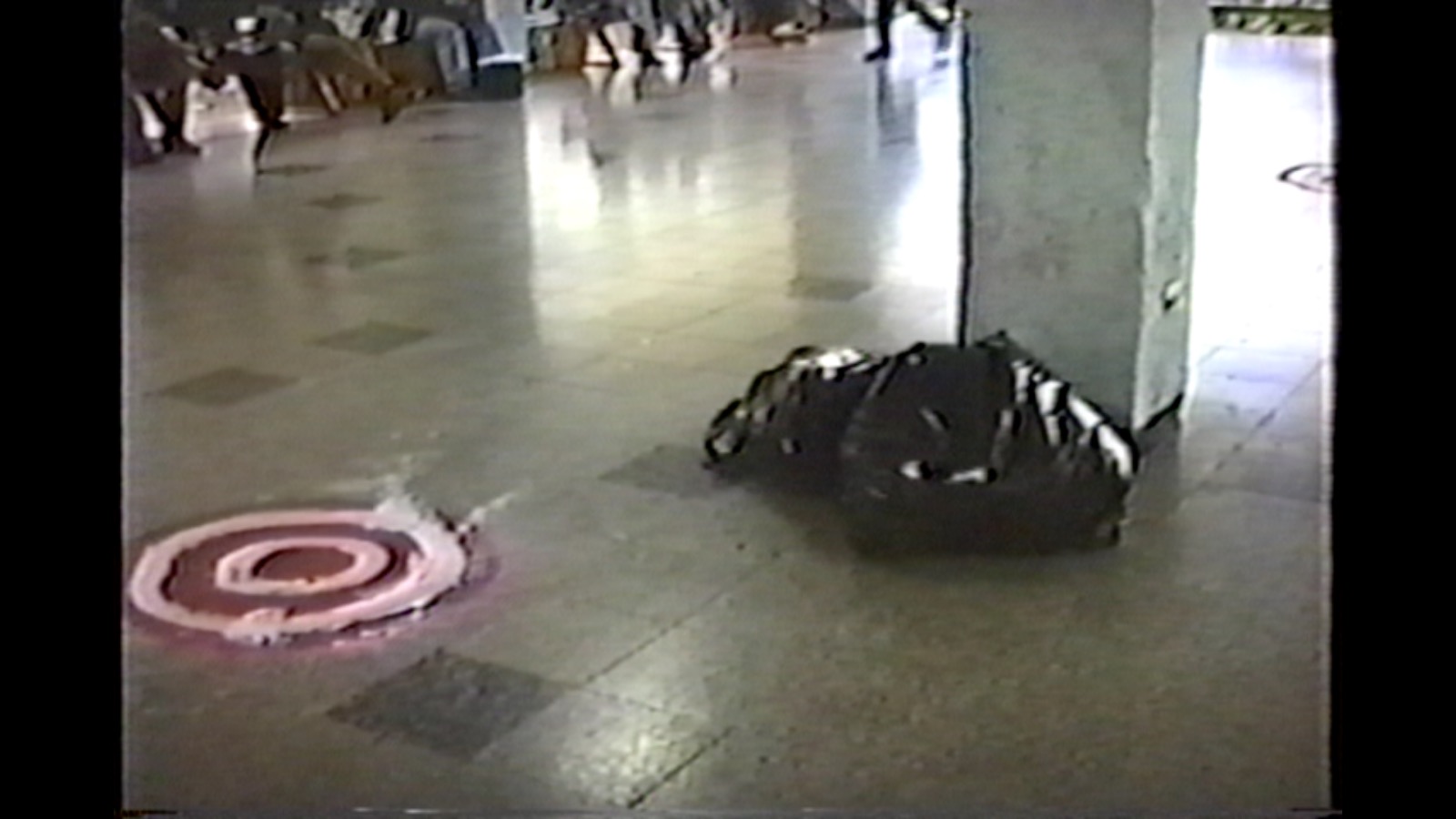
Recuerdo (1998)
Elena Tejada-Herrera
Recuerdo [Memory]
1998
Video with colour and stereo sound
3 minutes
Courtesy of the artist
search


Elena Tejada-Herrera
Recuerdo [Memory]
1998
Video with colour and stereo sound
3 minutes
Courtesy of the artist
Gilda Mantilla and Raimond Chaves introduce Recuerdo (1998) by Elena Tejada-Herrera:
‘We propose the video piece Recuerdo (1998) by Elena Tejada-Herrera. Like many of her other works, this film is related to, and documents, Tejada-Herrera's performance practice. It explores the uncertainty and desolation generated by deep economic crisis and political violence unleashed in Peru between the 1980s and 1990s. The artist is always attuned to the way social and political processes agitate the psyche and the feminine body, with a direct, unprejudiced and humorous approach.'
About the work:
Recuerdo [Memory] was performed on 28 August 1998 in the Universidad Nacional Mayor de San Marcos literature department at the invitation of Mihaela Radulescu. Emulating a corpse sealed in a plastic bag, Elena Tejada-Herrera dragged herself across the courtyard as she cried out the names of students murdered during the infamous La Cantuta incident (1992).
I
Before the performance, I painted red and white concentric circles on the floor that alluded to the Peruvian rosette, one of our national symbols. However, they also resembled target symbols. These circles marked my path during the performance.
I presented myself in a huge black plastic bag, like the body bags that store corpses in morgues. A man carried me from a hidden place towards a hallway within the university and placed me on the floor, over one of the rosettes, and then walked away. After a moment of silence, I started singing the following lyrics from a well-known Peruvian waltz:
Hate me, have pity, I beg you.
Hate me without limits and without mercy. Your hatred I want more than your indifference. Because hatred hurts less than oblivion.
Then, I called out the name Enrique Guzmán y Valle, also known as La Cantuta, one of the disappeared students who was kidnapped by the military from la Universidad Nacional de Educación in 1992 because he opposed the country’s regime. Later, the cremated remains appeared at a military training area in cardboard boxes used to transport milk cans. The key found in one of these cartons allowed to determine the murdered victim’s identity because it belonged to a university dormitory.
I called his name and recited details about the clothes he wore when he was disappeared. I also described his physical appearance and stated his age—all without revealing his identity.
II
For a while, I remained in silence and then crawled across the floor. After another moment of silence, I turned on a small radio inside the plastic bag and played music from one of the AM radio stations which are popular in dense urban areas, because they mostly broadcast music genres such as Chicha and Andean music and salsa. Then I became silent again, crawled across the floor from rosette to rosette, called out more names of disappeared persons and shared their descriptions, stopped, sang another part of the Peruvian waltz, named another missing person and that person’s description, and so forth. I crawled in silence, stopped, and then turned on the tape recorder to play music from the religious procession Señor de los Milagros—the most important religious rite in the Peruvian capital. Then I shouted another name and shared more personal descriptions, and added that ‘they had the keys’. I crawled, I stopped and became silent for a moment. After a few moments, I sang a stanza from the Peruvian national anthem. And then, the same person who had brought me there picked me up and took me away.
III
All the information I shared as I crawled inside the black plastic bag was provided to me by Peruvian human rights organisation APRODEH. Over the course of the performance, I mentioned everyone who had disappeared at the Universidad Nacional de Educación in 1992, but without explicitly identifying them. The number of stops at which I sang and/or turned on the radio corresponded to the number of people who had disappeared. The intention was to remind those present during the performance of these people as individuals with an affective history close to everyone.
Text by Elena Tejada-Herrera
Recuerdo [Memory] (1998)
Elena Tejada-Herrera
Peru
Performance documentation | 3 minutes
Spanish
This screening is part of the Genealogies in the Middle East and Latin America project, which explores historical and contemporary relationships between artists from these two regions. It unfolds along narratives revealed by the artists' personal accounts that provide critical alternative perspectives and insights by decentralising dominant narratives, schools and paradigms produced and affirmed in the West.
To learn more, please click here.
![Elena Tejada-Herrera: Recuerdo [Memory] (1998) Elena Tejada-Herrera: Recuerdo [Memory] (1998)](http://sharjahart.org/images/uploads/site-images/_thumbnail-image-retina/4-WHATSONEVENTSPAGE_800X600.jpg)
Sharjah Art Foundation presents a series of online film screenings jointly organised with Anna Goetz, who initiated this collaborative project featuring 21 artists and collectives from the Middle East and Latin America working in film and video.